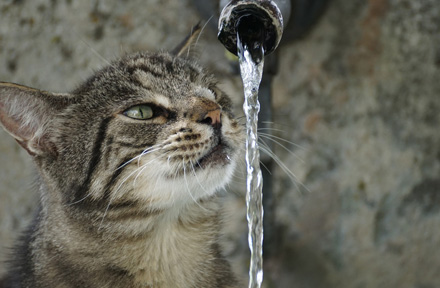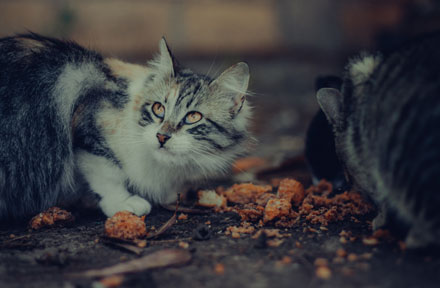Mar 24, 2023
Author:Lisa Martinez
Every cat owner loves a big chunky cat to cuddle, but how much food does a cat need is a basic question every cat lover asks before getting a cat on board. A cat's stomach is never full; if it has adequate calories, it would still look for food, leading to obesity and other secondary diseases. Naturally, cats have wild appetites that they fulfill by eating several small meals in the form of hunting and serving portions which often results in overeating and weight gain. That's why it's recommended to always learn about your cat's food requirements before feeding them excessively. Thus, in this blog, we will answer the query: how much food does an adult cat need daily?
Normally, a fully grown cat requires roughly 300g of wet food, but it's just a vague estimate as the food intake depends on several factors like age, size, health conditions, etc. Each cat has unique traits and food requirements, so that the food amount can vary with different individuals. Generally, the labels on the food packaging are enough to give you an idea about how much food an adult cat needs, as it includes different ranges to help you find where your cat falls.
However, here are the factors you can learn about your cat's requirements. If you are looking to know about a particular food or condition, then it's recommended to consult your veterinarian for the proper meal plan and portion size.

Age: Cat's age plays a vital role in determining its food requirements; kittens have more nutritional requirements than adult cats as they are of growing age and have high energy requirements. At the same time, adult cats need fewer calories.
Size & Weight: How much food a cat needs daily depends on size and weight. Like the largest domestic cat breed, Maine Coons eat more food compared to smaller breed cats like Siamese.
Hence, the cats vary in size and weight and have food requirements accordingly.

Body Condition: How much food your cat needs daily is also based on its body condition. If your cat has excessive weight and is less active, it requires less calorie intake, while an underweight cat requires more calories. Moreover, certain diseases also modify the nutritional demand of cats; cats with different illnesses and metabolic rate and their portion size must be adjusted accordingly.
Activity Level: Active cats in different activities burn more calories, requiring more food. Cats' metabolic rate at which they burn calories also plays a key role; cats with high metabolic rates require higher nutrition.

Food Quality: Food quality is also important in determining food intake. Usually, canned foods are recommended to maintain a healthy diet for your cat, and that also only twice a day in rightly measured quantity. However, you need to be very careful with measures when feeding dry food to your cat as it can cause weight gain in cats if not given in the right portions.
Spayed or Neutered: Spayed and neutered cats don't need many calories; they need calorie reduction. These cats have a slow metabolism due to a lack of hormones.
Pregnant or Nursing: Life stages are all that matters the most in feeding; pregnant and nursing cats, just like humans, have high nutritional demand because they need more calories. Hence, these cats have different food requirements than normal cats, and it is suggested that you always leave some food out for your cat to get enough calories to increase their metabolism.
If you are a cat lover or owner, you will find aisles and aisles of grocery stores filled with various cat foods. From complimentary, complete food to wet and dry, many kinds of food are available in supermarkets, but the most common and efficient of them are wet and dry foods.
Wondering how much wet food does a cat need? Dehydration in cats is very common, and low-moisture foods usually cause it. Wet foods, in that regard, work best with cats because it provides the right amount of water to cats, so they don't need to rely on drinking water. These foods have more than 60% water content and a long shelf life, but it's perishable once opened.
The main drawback of wet food is that it gets spoiled early, so to avoid this, divide your cat's calories per day into two portions. A cat weighing 5 kg should be served 200g of wet food divided into 2-3 meals.

Wet foods are expensive, but the best thing is it plays an integral part in maintaining your pet's health: it helps maintain weight and urinary health and prevent constipation.
Dauntlessly dry food is an affordable option, but we don't suggest frequent dry food feeding as it is an unhealthy option. The biggest drawback of dry food is that it is highly calorie-dense and has less than 14% water content, making it less voluminous. Dry gives the cats an adequate amount of calories, but it doesn't fulfill their appetite and makes them hungrier; in that case, you would feed them again and again, which would cause weight gain. To answer this frequently asked the question, how much dry food does a cat need? We can see that a cat weighing around

5 kilograms should be given around 80 grams of dry food daily. Properly measuring dry food is very important; otherwise, your cat will overeat.
Both kinds of foods have their benefits, so if your cat is overweight and has lower urinary tract issues and constipation, you must use wet food for your pet. While if your cat is skinny, you must opt for dry foods as it's very efficient in providing calories.
Just like humans, cats also have simple appetite anatomy; once they are full, the digestion process takes a few hours, and the stomach empties after at least eight hours. According to this cycle, at least two meals daily are perfect for adult cats. You can also give complimentary food in small portions once a day in between, but two proper meals are very important. You can schedule the feeding time according to your family schedule and feed your cat in small portions, but you must also consider that too many meals can make your stomach hyper-acidic, so you must be really careful. You can feed your cat in two common ways: free feeding and scheduled feeding.
Free feeding is acceptable only when your cat has traits of great self-control. Free choice feeding is not for cats that like to snack all the time and are eager for food, as they would gain too much weight. Free feeding has its side effects, as the foods, be they dry or wet, get spoiled if left out for a long time. So if you are free feeding your cat, make sure that you keep the food fresh to prevent it from spoiling because it may cause some serious health issues in your cat, like diarrhea, bloating, and constipation. However, free feeding can help greatly in weight gain, so if you are looking for alternatives that can help add some extra pounds to your cat, you should try this type of feeding. And also, for cats with lower-than-average food requirements, you can certainly serve them free choice food.

Scheduled feeding is an ideal way of feeding: it teaches your cat about proper routine. Cats are habitual, and feeding on a regular schedule helps them learn the predictability and security of a routine. A scheduled feeding can be beneficial in many aspects; one of the most important is that it helps you make food changes easily. When cats habitually eat at a specific time, their body expects the food at that particular time, and they eat whatever they get. Another benefit of scheduled feeding is that you know about any underlying illness of your pet immediately.
Whenever your cat stops taking a meal at its scheduled time, it signals that he is disturbed or has some illness.
Scheduling the feeding time can be challenging for some cat owners because of their tough routine; in that case, one can try automatic feeders. If you are looking for a product that can help you maintain the scheduled feeding for your cat, then you must opt for these automatic feeders for them.
WOpet Automatic Timed Feeder can be a great savior in scheduled feeding; this product helps maintain not only your pet's healthy feeding plan but also a healthy weight for it. This product has some amazing features that help set a hygienic routine for your pet. Special features include a memory feature that works even during a power outage, a child lock function that prevents accidental touch, and personalized meal calls that play when you are dispensing the food.

Popular Post

What to Feed a Sick Dog With No Appetite? [2025 Guide]
May 16, 2023

Troubleshooting Common Issues with Automatic Pet Feeders: Tips & Tricks for Pet Owners
Oct 26, 2023

Why Does My Cat Cough After Drinking Water? 8 Potential Reasons
Mar 13, 2023

Why is My Cat Throwing up Water? Top 5 Causes Here
Feb 08, 2023

My Cat Only Eats A Little at A Time - What to Do?
Feb 27, 2023
$99.99
$129.99
Copyright © 2025 WOPET. All Rights Reserved.